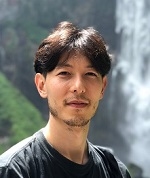Inner Diversity<3>
Contribution by Shimoji Lawrence Yoshitaka,
Visiting Scholar, University of Hawaii
The Reality of Diversity in Japanese Society and the Perspective of Intersectionality
November 1, 2022
[Special Feature 076]
Special Feature: Inner Diversity (See here for an overview of this special feature)
Through his media and research, Shimoji Lawrence Yoshitaka conveys the voices and situations of people with roots in multiple countries. In this article, he examines the state of Japanese society as seen through his activities, and questions how people should interact with each other using the concept of intersectionality, which is garnering attention through such contexts as Black Lives Matter*1 and feminism.
The Reality of Diversity in Japanese Society and the Perspective of Intersectionality
Shimoji Lawrence Yoshitaka
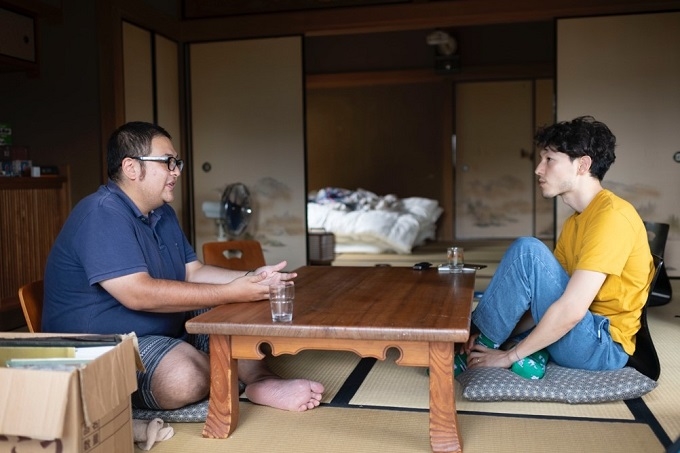 (Photo by Tagawa Motonari)
(Photo by Tagawa Motonari)What does intercultural cohesion and internationalization mean to you?
What sort of situations do you think of when you hear the words intercultural cohesion and internationalization? Imagine, for example, the following.
It's lunchtime, so you start eating lunch with a friend or colleague.
You eat a ham and lettuce sandwich that you bought at the convenience store this morning.
You seem to buy the same thing every day, but you're not bored of it yet.
You enjoy the casual conversation with your friend during lunch.
Perhaps you feel that the words intercultural cohesion and internationalization are both terms about situations between countries on a global scale, and have nothing to do with you, or perhaps you feel that they're grandiose terms that don't have any sense of reality for you. But perhaps hints of these terms are actually hidden within everyday scenes like the above, or in the backgrounds behind them.
Maybe when you bought that sandwich at the convenience store this morning, the part-time employee at the register was an exchange student who had come to Japan from overseas. And maybe the person who packed the sandwich at the factory, or the person who delivered it to the convenience store by truck, are ethnic Japanese from South America who came to Japan and reside here as permanent residents. Maybe the lettuce sandwiched between the bread was grown and shipped by a technical intern trainee from overseas working at a farm. And maybe the friend or colleague speaking to you right now in front of you moved to Japan from overseas when they were young, or maybe one of their parents is from a foreign country. Or maybe their grandparents, or an earlier generation, were immigrants to Japan. How would you feel if that were the situation in which you found yourself as you enjoyed the sandwich?
These situations I have described are by no means impossible. For example, the Japanese government has launched the plan for 300,000 international students that aims to host 300,000 international students in the country by 2020, but that target was already exceeded in 2019. While the number of exchange students did decline 10% in 2020 to about 280,000 due to the Covid-19 pandemic, the fact remains that many exchange students live, study, and work in Japan and help support the lives of the people and the economy of Japan.
Meanwhile, there are the Nikkeijin, descendants of Japanese people who migrated overseas in the past. Given that Japanese society faces serious problems, such as the aging society and the labor shortage, the Japanese government established a new status of residence called "Long-Term Resident" through a revision of immigration law in 1990. Many 2nd and 3rd generation Nikkeijin moved to Japan from South America under the new status. While many were forced to return to their home countries under the massive layoffs caused by the Lehman Shock in 2008, many others have continued to live in Japan over the long term, establishing their roots for daily life here.
Also, the Japanese government established the Technical Intern Training program in 1993, a program designed to train and teach skills, but in fact many laborers have moved to Japan to live and work here under the program. Furthermore, the government added a Specified Skilled Worker category to the program in 2019 to supplement it. The number of foreign workers in Japan continues to grow each year, and the rate of growth is accelerating due to the expansion of the program in recent years. As of October 2020, the population of foreign workers here reached 1,724,328*2 people, a record high despite the Covid-19 pandemic.
Meanwhile, the number of children born to mixed parentage, where one parent is a Japanese citizen while the other is a foreign citizen, has risen to a level of 20,000 per year in recent years. As of 2021, approximately 2% of all births in Japan, or one out of every 50 births, is a child born from mixed Japanese and foreign parents*3. It is estimated that as of 2015, approximately 840,000 people*4 born of parents with mixed nationalities live in Japanese society, and it is believed that the number continues to increase. It is easy to assume that foreigners are those with connections to foreign countries, and Japanese are those without connections to foreign countries, but in fact, there are many Japanese citizens with overseas roots, such as those who changed their nationality to Japanese, or those born to international marriages.
Though there are those who see the terms intercultural cohesion and internationalization as distant and unrelated to themselves, the fact is that there are those around them who live, work, or learn together with them. In other words, those people are in fact involved with our daily lives in this society whether or not we actually see each other. This is not some story from a different world, but the very reality that is happening right in front of us.
There are politicians who repeatedly claim that the Japanese are a single race while stubbornly refusing to use the word "immigrant". However, that language does not reflect the reality which is so clearly shown by the statistics. In other words, the category of the Japanese people, which were thought to be a single group, is already quite diverse on the inside. Diversity is not a question for the future, of "how to accept each other moving forward". Diversity instead is already about the existing reality of Japanese society. If you look at the many individuals who live, eat food, buy clothing, work, study, and play in this same society as you, you will see the reality of that diversity.
Just like making an international contribution, it is of course important to travel out of Japan and contribute overseas. But when we speak of intercultural cohesion, internationalization, and diversity, it is important to start with your immediate surroundings, or even to start within yourself, rather than seeing them as something distant that is unrelated to you.
The experiences of the Hafu and Mixed
I have long studied the experiences and history of those members of Japanese society called Hafu and Mixed, or people who are half Japanese or mixed ancestry. As part of that, I helped found the website
Hafu Talk
with Keane Julian and Cecilia Hisako in 2018 as a place for people to share information about overseas roots and being Hafu.
Before then, a search for the word Hafu on the Internet only yielded information such as "Lists of Half and Quarter (Japanese) Entertainment Personalities" or "How to wear makeup to look Hafu". That is not to say that there were no websites at all which could meet the need on the part of those called Hafu and Mixed to learn about others like themselves, but there were in fact very few, so the three of us launched the project out of our desire to create such a place.
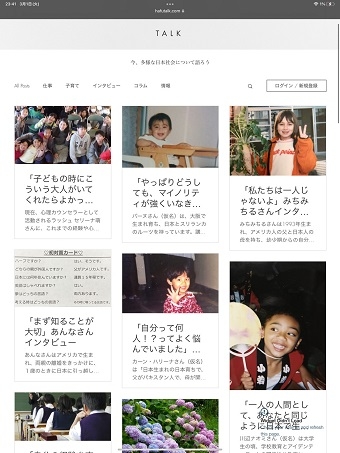 Website Hafu Talk
Website Hafu Talk
In my experiences related to Hafu people, the focus had typically been placed on the lives and activities of entertainment personalities or professional athletes, and the problem there was that it was hard to compare their exceptional experiences with my own. For that reason, I have written numerous columns and interviews out of a desire to speak of the experiences of the average person on the street, rather than famous people.
For example, Kawabe Naomi (pseudonym) spoke the following during an interview describing her experience in middle school.
I was in classroom 1 in the third year of middle school, which was at the far end of the hall. I had to pass by all the other classrooms to get there. But when I walked by those classrooms, the troublemakers would all hang out at the doorways and would always, without fail, call out the names of black foreign athletes or popular black entertainers at the time, over and over again. It's not so much that I didn't like being called those names, but that I didn't want others to hear me being called those names. I really hated being seen when I was being called those names. I could never tell when it would happen, so I made an effort never to leave the classroom as much as possible.
Halina Khan (pseudonym), who describes herself as being "Born and raised in Japan with a Pakistani father and Japanese mother from Kansai," spoke to me about her experience job hunting.
All of the job interviews I went to were, luckily, normal, but I was really bad at self introduction. There was one interview where, because I didn't mention that I'd been to Japanese middle school, they asked, "Can you write Japanese?" and said, "Your writing (on your resume) is very good, like a Japanese person's." I am sure the interviewer thought they were complimenting me, but it's weird to say, "Your writing is like a Japanese person's" to a Japanese person, isn't it? Even though I really wanted a job, it was very stressful to have to explain where my parents were from every time, and it slowly wore me out.
Perhaps some might think that an experience on that level should just be ignored. But there is an idea prevalent in Japanese society that you have to consign people to being either "Japanese" or "Foreign", that it has to be one or the other, and we continue to be effected by it every day. In reality, we cannot simply separate people into Japanese and foreigners. Rather, there are people living in Japan with all manner of roots, more like a gradation. But the mistaken perception that the Japanese are a single ethnic group is still strong, meaning that those who are Hafu or Mixed are ostracized from the worldview that only accepts the binary choice of Japanese or Foreigner.
Try to imagine what that is like. The fact is that there are people born and raised in Japan, with Japanese nationality, and who speak Japanese, but who are constantly asked, "Are you Japanese?" by people they don't know every single day. That one question may seem small and insignificant, but if you are constantly spoken to with those hurtful words on a daily basis, they continue to deepen your emotional scars.
In addition to Hafu Talk, I also work with editors and photographers to write interviews for the website Nippon Complex Travels. I had one interview with Regina, who revealed her experiences and concerns to me.
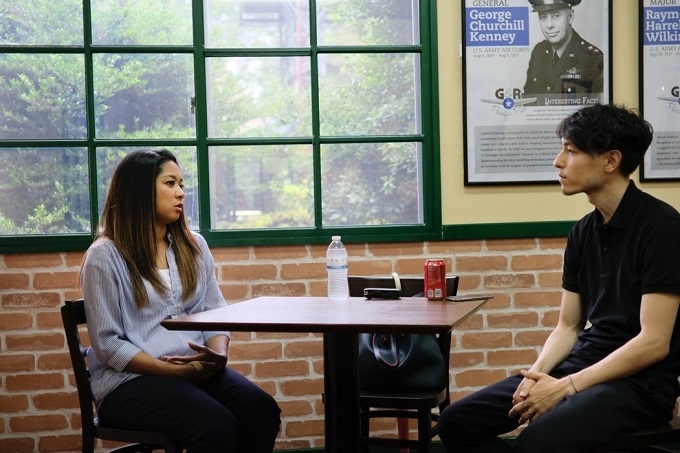 My interview with Regina (Photo by Tagawa Motonari)
My interview with Regina (Photo by Tagawa Motonari) To be honest, I'm just a bundle of psychological complexes. I love to joke around, so people think I don't have any worries. But I still have psychological complexes I'm working through. Of course, I'm sure there are Hafu people who grew up without having these experiences. But in my case, I was told all sorts of things due to the color of my skin when I was a child, and I really hated that. I could never respond no matter what I was told. To be frank, I wanted to make myself white, though maybe saying "bleached" would be extreme. I don't think that anymore, but there are still times where I feel like I'm being stared at. If someone says, "Oh, just don't worry about it", then of course, they're right, but for someone like me who suffered from that, it still bothers me.
In addition to those who have a parent with foreign roots, there are many people living in Japan who have foreign roots through relatives from older generations as well. Kuroshima Thomas Yuki, who is also quarter Japanese like myself, described the story of his family over three generations, from the meeting between his grandfather, an American soldier, and his Japanese grandmother, his father who survived as half Japanese during a particularly challenging time, and his own life as an Amerasian from Naniwa.
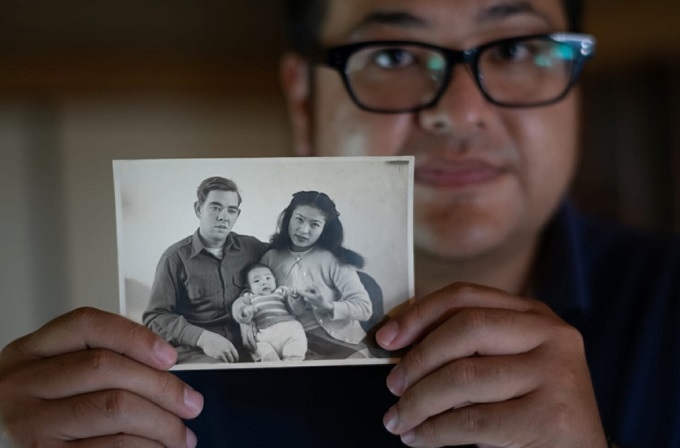 Thomas holding a photo of his family (Photo by Tagawa Motonari)
Thomas holding a photo of his family (Photo by Tagawa Motonari)
Like Thomas, my grandfather was also an American soldier. He met my grandmother in Okinawa, and they gave birth to my mother. Many think of people of younger generations when they hear the word Hafu. But in fact many children like my mother were born in Japanese society after WWII, and who are today reaching an age in the 60s or 70s. My mother still works as a cleaning lady in an apartment building.
So when you imagine that the people around you, whether the cleaning staff at your apartment building, the staff at the convenience store where you bought lunch this morning, the people you pass on the street, your colleagues, or even friends, all come from numerous backgrounds as they live their lives, it leads to an understanding of our complex reality. You can take the first step in understanding the diverse reality of society if you communicate with the assumption that the person in front of you is different from you, rather than seeing them as being just like you and closing your eyes to the differences.
My mother was born and raised in Japan and only speaks Japanese. But because of her appearance, she says the people around her still compliment her Japanese or ask her how long she's lived in Japan, even past the age of 70. So the reality is that she is still not recognized as Japanese even after 70 years have passed. While the binary idea that one can only be Japanese or foreign, not both, is still strong, the reality is complicated with diverse people living here today and in the past. Thus Japanese society has been formed by each one of these complex and diverse people.
The concept of intersectionality
The complexity and diversity of each individual living in Japanese society is not limited to whether or not they have foreign roots. The complex reality is actually created through the intersection of countless factors such as gender, sexuality, race, ethnicity, membership in indigenous groups, age, regional background, class, economic status, nationality, citizenship, religion, and culture. For example, even people who all identify themselves as Japanese will have very different experiences due to their different ages, and will face different situations due to their gender or sexuality. And of course there are other major differences in the social issues they face due to family economic situation, race and ethnic background, and whether they live in urban or rural environments. The reality of the intersections of these factors is what forms the social status of each individual and the structure of society.
Intersectionality is the concept of seeing our complex reality, with countless factors overlapping and interacting, for what it is, rather than trying to simplify it to fit into a generalized diagram, and focusing on the intersections of those many factors. I supervised the publication of the first Japanese text on the subject, Intersectionality (Patricia Hill Collins, Sirma Bilge, Obara Ayano translator, published by Jimbun Shoin). I recommend reading that book if you wish to know more.
A major catalyst behind the emergence of this term was a paper written by Kimberlé Crenshaw, a black feminist and legal scholar in the US. Crenshaw aptly used the word intersectionality to explain the way that gender had never come under attention as part of the black movement, and the way that race had never come under attention as part of the feminist movement, as a result of which the experiences of black women, who stood at the intersection of these movements, were ignored. Thus, intersectionality is the idea of bringing focus on those who exist in intersectional positions in society who had previously been invisible, while also examining the reality of the repression and discrimination resulting from the intersections and interactions of complex factors such as gender, class, and race, within the structure of society.
The concept soon spread beyond black feminism and was adopted in many other minority women's movements. Today, not only has it spread to all aspects of sociology, it is also being applied to such wide ranging fields as the environment, health and sanitation, and disaster research, as well as being included in discussions on human rights by the UN. The term is also beginning to take hold in Japan, appearing in numerous research papers and events that attempt to explain numerous issues using the concept.
Naomi, the woman from the interview above, had this to say at the end of the interview.
I want people who work in education to understand that there are many different kinds of people, that people are diverse in terms of race, sexuality, religion, and other factors. Because every person is special and wonderful. Sure, we Hafu may be different in terms of race, but that doesn't mean it's just us who are special. We don't want to be treated as special. We want to be treated normally, to be treated properly as normal people. We need a society that sees us as just one of the ways people are different, in the same way that some may be athletic, while others are smart, and there are people who are both tall or short, or left handed versus right handed. I just want people to stop seeing us as something special. We're just people, and we were born and raised here in Japan just like you.
Naomi's message explains the idea of intersectionality in a very easy to understand manner. To put that in other words, it means that diverse and complex people are living together side by side at the intersection of these numerous factors in Japanese society.
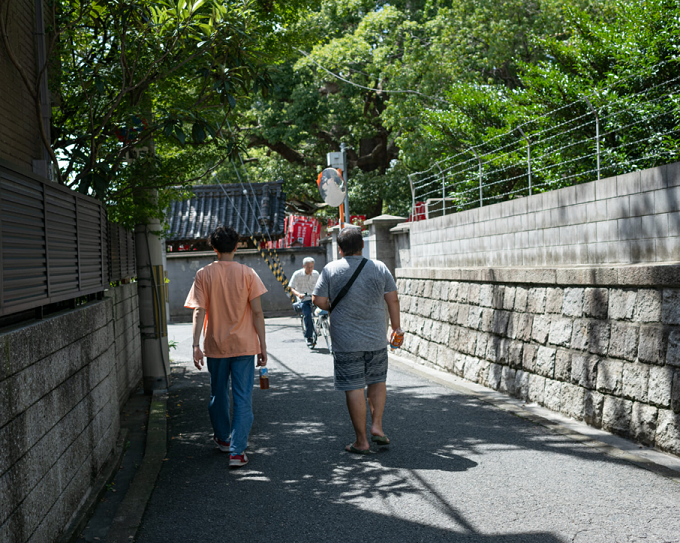 From Nippon Complex Travels (Photo by Tagawa Motonari)
From Nippon Complex Travels (Photo by Tagawa Motonari)
People with diverse status and roots live in Japan, such as resident Koreans, Ainu, sexual minorities, LGBTQ, Okinawans, Hafu and Mixed people, returnees who spent part of their lives outside the country, those from discriminated villages called Buraku, the disabled, and albino people. Furthermore, through the perspective of intersectionality, there begin to emerge other individuals who were hard to see within the major categories, such as an elderly resident Korean woman, a disabled Ainu person, a member of a sexual minority living in Okinawa, or a single half-black mother living in poverty. It is important to listen to each and every one of those people.
So what does it mean to respect the other given this reality of so many diverse people? I sometimes hear the slogan, as just one example, "Overcome differences of country, race, and gender and come together!" for respecting diversity. But should we really try to "overcome" the "differences" between ourselves and others?
The idea of intersectionality promotes an attitude that is the complete opposite. That is to say, rather than trying to overcome or ignore differences with others, recognize those differences for what they are and try to face them.
It is important to have an attitude to face the differences with the other and consider how to work together given those differences, rather than overcoming, forgetting, or ignoring them, and that's what it means to respect the other.
And it is not only other people who are diverse and complicated. When you reflect on yourself, you find that in some cases you are in an advantageous position as a member of the majority, while in others, you are subject to repression and unfairness as a member of the minority. And when you reconsider the diversity and complexity within yourself, then you become able to face the differences between you and others in a different manner.
As I have already explained, Japanese society today is already home to diverse and complex people, and that diversity will increase as members of global society come and go more and more. And the concept of intersectionality has made it possible to see the previously hidden intersections and complexities of society, and for those who had previously remained unheard to gain a voice.
So perhaps internationalization and diversity begin between you and those around you, right in front of you, or even when you reconsider yourself, rather than being something that occurs in some distant world.
- *1 Black Lives Matter: a movement calling for the elimination of violence and racial discrimination against African Americans which began after an African American man was assaulted and killed in the US by a white police officer.
-
*2 Source: Ministry of Health, Labour and Welfare, "Summary of Notification of Employment Status of Foreign Nationals (as of October 31, 2020)"
https://www.mhlw.go.jp/content/11655000/000729116.pdf -
*3 Source: Ministry of Health, Labour and Welfare, "Annual Trends in Births by Nationality of Parents"
https://www.mhlw.go.jp/toukei/saikin/hw/jinkou/suii09/brth8.html - *4 Source: Korekawa Yu, 2018, "Transitions in International Population Migration in Japan and the Medium and Long Term Prospects: Beyond Japan-Centric Theories," Journal of Migration Policy Studies (10): 13-28, The Japan Association for Migration Policy Studies
(Notes)
・This article uses the term "disability" from the perspective of the social model, in which the disability is with society, rather than the individual or medical model, in which the disability is with the individual. Note that universal design company Mirairo explains that the reason that the term Shogaisha in Japanese, or "disabled person," is written entirely in Kanji (障害者) rather than partly in Hiragana as is common (障がい者) is because some screen reader applications on computers misread that spelling as "Sawarigaisha" (Reference: https://www.mirairo.co.jp/company).
[References]
Shimoji, Lawrence Yoshitaka, What is 'Hafu'? Reality Versus Your Imagination (Heibonsha, 2021)
Shimoji, Lawrence Yoshitaka, 'Mixed Race' and 'Japanese': A Social History of Hafu Double, and Mixed Race (Seidosha, 2018)
Patricia Hill Collins, Sirma Bilge, Intersectionality, translated by Obara Ayano (Jinbun Shoin, 2021)
Contributed March 2022
All photos courtesy of the author
Related Articles
Keywords
Back Issues
- 2025.7.31 HERALBONY's Bold Mis…
- 2024.10.25 From Study Abroad in…
- 2024.5. 2 People-to-People Exc…
- 2022.11. 1 Inner Diversity<3> <…
- 2022.9. 5 Report on the India-…
- 2022.6.24 The 48th Japan Found…
- 2022.6. 7 Beyond Disasters - …
- 2021.3.10 Crossing Borders, En…
- 2020.7.17 A Millennium of Japa…
- 2020.3.23 A Historian Interpre…


